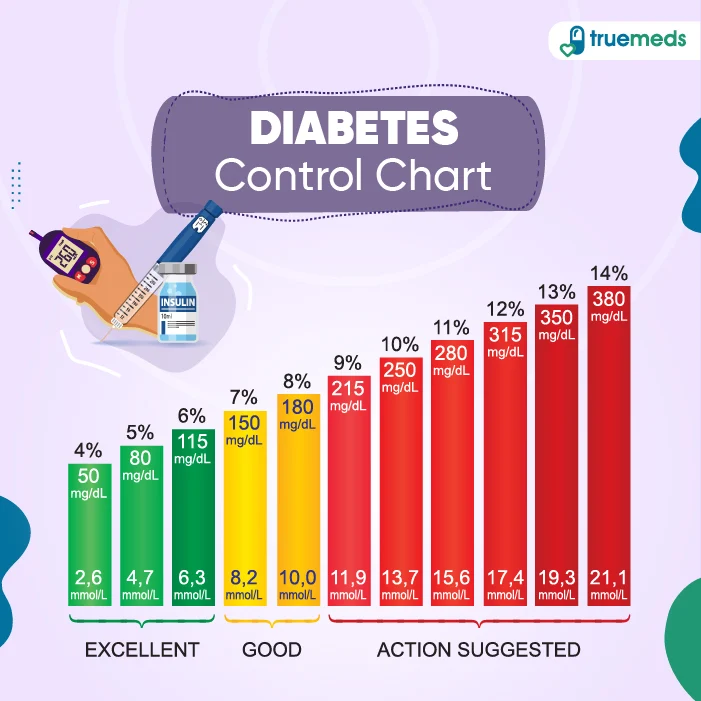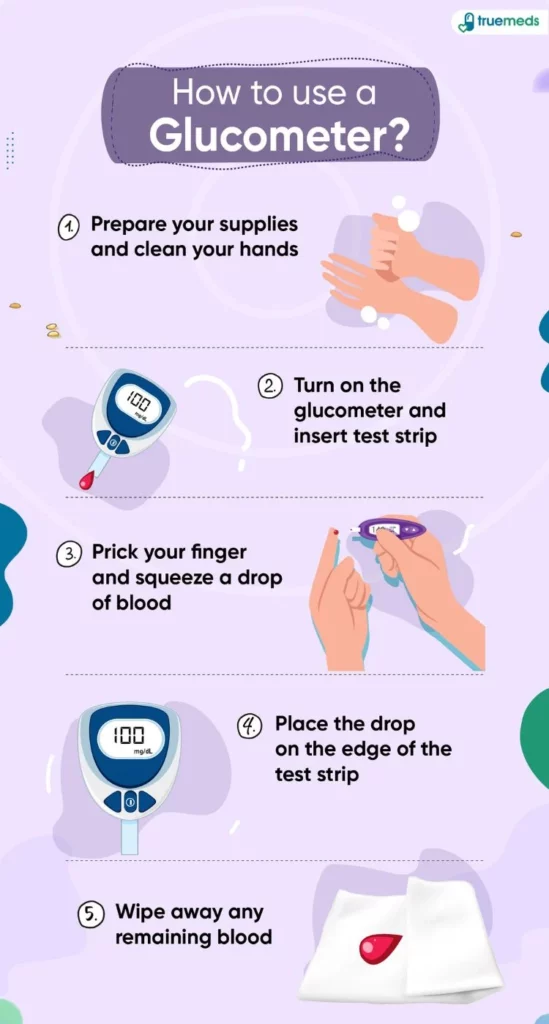Normal Blood Sugar Level Chart
Last updated on : 18 Oct, 2024
Read time : 12 min
Diabetes occurs when our bodies are unable to regulate blood sugar levels. There are 3 main types of diabetes. Type 1 diabetes, Type 2 diabetes, and gestational diabetes. In type, type 1 diabetes, the body’s immune system attacks and destroys pancreatic insulin-producing cells. Without insulin, sugar can’t enter cells for energy, causing blood sugar levels to rise. It often begins in childhood or adolescence. Type 2 diabetes is more common and usually develops later in life. During this condition, the body doesn’t use insulin properly; over time, the pancreas can’t produce enough insulin to keep up. The third type of diabetes i.e. gestational diabetes occurs when the body cannot produce enough insulin to meet the increased demands during pregnancy. This can elevate your blood sugar levels. While it often resolves after childbirth, it increases the risk for both the mother and child to develop type 2 diabetes later in life.
If blood glucose levels are higher than normal values but not as high as type 2 diabetes, this condition is called prediabetes. It’s a warning sign that indicates an increased risk of developing diabetes in the future.
Knowing the normal blood sugar level helps you set a target for managing diabetes. Regularly checking glucose levels allows you to monitor and adjust lifestyle choices, medications, and diet. It enables you to better control blood sugar levels and prevent complications. This proactive approach helps to make informed decisions for diabetes management. Let’s explore what are normal prediabetes and diabetes blood sugar levels. Also, know the common diabetes symptoms and how you can check whether you have diabetes or not at home.

What are the Common Symptoms of Diabetes?
Common symptoms of diabetes can vary, but they often include increased thirst and hunger, frequent urination, and unexplained weight loss. Some may experience fatigue, blurred vision, and slow-healing wounds or infections.
In type 1 diabetes, symptoms can develop quickly and might include extreme thirst, frequent urination, sudden weight loss, and fatigue. Those with type 1 diabetes often experience increased hunger despite eating.
For type 2 diabetes, some people may not experience noticeable symptoms at first. The symptoms may develop gradually. These include frequent urination, increased thirst, fatigue, blurred vision, and slow wound healing. Some people may not experience noticeable symptoms at first.
It’s important to note that symptoms can vary, and some people may not experience any noticeable signs initially. If you suspect you have diabetes or are experiencing these symptoms, it’s essential to get your blood glucose levels checked and consult a doctor for a proper diagnosis.
Also read: How to stop frequent urination
What is the Role of Blood Sugar in Diabetes?
Blood sugar, or glucose, plays a crucial role in diabetes. Our body tries to regulate blood sugar levels effectively during diabetes. If your blood sugar levels are high, you are at high risk of various complications that can affect organs and systems over time. It can damage nerves and blood vessels and increase the risk of heart disease and stroke. Nerve damage may cause tingling or numbness, especially in the feet. Eye problems, including blindness, can occur. Kidney damage may lead to kidney failure. Your wounds may heal slowly, and infections can be more severe. Maintaining blood sugar within the normal range can prevent complications and manage diabetes effectively. Following a comprehensive diabetes diet chart can be an essential part of this management.
What is a Normal Blood Sugar Level Range?
The normal sugar level for a person usually ranges between 70 to 100 mg/dL before meals, and it should be below 180 mg/dL two hours after eating. These levels help keep the body energized without leading to health issues.

Categories of Blood Sugar Levels
Blood glucose levels are typically categorized into three ranges: Normal, Impaired Glucose (also known as Prediabetes), and Diabetic. Here are the specific values for fasting after eating (postprandial), and 2-3 hours after eating:
a) Fasting Blood Glucose Levels (mg/dL):
- Normal: Less than 100 mg/dL
- Impaired Glucose (Prediabetes): 100-125 mg/dL
- Diabetic: 126 mg/dL or higher
b) Blood Glucose Levels 1-2 Hours After Eating (Postprandial) (mg/dL):
- Normal: Less than 140 mg/dL
- Impaired Glucose (Prediabetes): 140-199 mg/dL
- Diabetic: 200 mg/dL or higher
c) Blood Glucose Levels 2-3 Hours After Eating (mg/dL):
- Normal: Returns to less than 140 mg/dL
- Impaired Glucose (Prediabetes): Typically between 140-199 mg/dL
- Diabetic: 200 mg/dL or higher
These ranges are essential for diagnosing and managing diabetes and prediabetes. Regular monitoring can help manage the condition effectively and prevent complications. Always consult with a healthcare provider for personalized advice and recommendations.
Blood Sugar Levels Chart for Adults with Diabetes
The following is the blood sugar level chart for non-diabetic, prediabetic and diabetic adults:
| Category | Blood sugar value after 8 hours of not eating or fasting value in mg/dL | Blood sugar value after 2 hours of eating or postprandial value in mg/dL |
| Normal or non-diabetic | 99 or below | Less than 140 |
| Pre-diabetic | 100-125 | 140-180 |
| Diabetic | 126 or above | 200 or above |
What is a Random Blood Sugar Test, and How Does it Help Manage Diabetes?
A random blood sugar test measures glucose levels in the blood at any given time, regardless of when or what you last ate. During this test, blood is drawn, usually from a fingertip. To do this test, a doctor or a healthcare professional pricks your finger puts a blood sample on a test strip and inserts it into a glucose meter. The meter then provides a reading of your blood sugar level.
This test helps manage diabetes by providing real-time information about how your body is processing glucose. It helps individuals with diabetes to assess the impact of meals, medications, and lifestyle choices on blood sugar levels. By monitoring these levels regularly, you can adjust your diet, medication, and activity level to keep your blood sugar within a normal range. This proactive approach aids in preventing diabetes-related health complications.
How Can You Check Your Blood Glucose Levels at Home?

There are several methods to check blood sugar levels at home. You can choose the suitable blood glucose recording method according to your preferences, the frequency of monitoring needed, and your doctor’s recommendations. Here are a few ways to record your blood sugar at home:
1) Blood glucose meters
Blood glucose meters or glucometers use a small blood sample, usually from a fingertip, to measure glucose levels. The blood drop is placed on a test strip, and the meter provides a digital readout. It is a quick and easy way to measure glucose in a small blood sample. Regular use of glucometers helps you make timely adjustments to medications. Here are the simple steps to use a blood glucose meter at home:
- Wash your hands with soap and water. Ensure they are completely dry before testing.
- Load a lancet into the device, adjusting the depth setting if necessary.
- Insert a fresh test strip into the meter as per the device instructions.
- Prick your fingertip with the lancet device. Collect a small drop of blood.
- Touch the blood droplet on the strip.
- The glucometer will display your blood sugar level.
- Keep a record of your results, and if you observe any unusual readings, report them to your doctor right away.
2) Continuous glucose monitoring (CGM)
CGM consists of a tiny sensor placed under the skin, typically on the abdomen. This sensor measures glucose levels in the interstitial fluid, providing frequent readings. The sensor is wirelessly linked to your smartphone through an app. You can share this real-time data with the doctors. Older adults can share this data with their caregivers.
3) Flash glucose monitoring
Similar to CGM, Flash glucose monitors uses a sensor, but instead of continuous readings, users scan the sensor with a reader or smartphone to get glucose information.
4) Urine test strips
Obtain urine test strips from a pharmacy. Ensure you have a clean container for collecting a urine sample. Use a clean container to collect your urine sample. Dip the test strip into the urine sample, ensuring all the pads on the strip are submerged. Gently tap the strip against the rim of the container to remove excess urine. Read the instructions on the packaging for the waiting time for the reaction to occur. Check the colour of the pads on the strip against the colour chart. Different colours indicate varying levels of glucose. While urine test strips are very easy to use for diabetes determination, this method is not as accurate as blood glucose meters.
Also Read: How to Stop Frequent Urination
Takeaway
If you are consistently experiencing symptoms like increased thirst, fatigue, weight loss, or slow wound healing, you may be having diabetes. Its early detection can prevent the severity of the condition and reduce the risk of complications such as nervous system dysfunctioning, heart disease, stroke, kidney damage, and vision problems. Being aware of normal glucose levels and sticking to that range can help you prevent diet and lifestyle-associated diabetes.
Those with pre-existing diabetes should regularly monitor their blood glucose levels. You may use blood glucose meters, continuous glucose monitoring (CGM), and flash glucose monitoring to record your readings. This can encourage you to make informed decisions about your meals of the day, activity levels and medications. You can also take a random diabetes test from your nearby lab to get real-time insights. Modify your lifestyle choices in such a way that your blood sugar lies in the normal range of 70 to 100 mg/dL before meals and below 180 mg/dL two hours after eating.
FAQs
Yes, you can check your own blood sugar level using a glucometer. This portable device measures your blood glucose levels from a small drop of blood, usually taken from your fingertip. By regularly monitoring your blood sugar, you can better manage your diabetes and make informed decisions about diet, exercise, and medication. Always follow the instructions provided with your glucometer and consult your doctor for guidance on how often to test and what your target levels should be.
A blood sugar level of 135 mg/dL after 8 hours of not eating is considered high and falls within the prediabetes range. It indicates impaired glucose tolerance, emphasizing the need for lifestyle modifications and monitoring to stop diabetes progression. However, a blood sugar level of of 135 mg/dL after 2 hours of eating is considered normal.
A blood sugar level of 120 mg/dL after eating is generally considered within the normal range.
A blood sugar level of 200 mg/dL is considered normal. It falls into the hyperglycemic range and indicates that you have diabetes.
There is no specific “normal” blood sugar level based solely on age. The general fasting blood sugar or blood sugar value after 8 hours of not eating for adults at the age of 50 is typically 90 to 130 mg/dL before meals and less than 180 mg/dL after meals. However, individual health conditions and factors may influence what is considered a healthy blood sugar level.
During pregnancy, an alarming blood sugar level would be a fasting glucose level consistently above 95 mg/dL, one hour after meal and consistently exceeding 180 mg/dL. Elevated blood sugar during pregnancy may indicate gestational diabetes. It needs prompt medical attention to reduce risks for both the mother and the baby.
You can reduce blood glucose levels quickly by taking insulin. Exercise is also an efficient way to lower your glucose levels. Opt for foods such as quinoa, vegetables, and barley that have a low glycemic index. Consult your doctor if you need other medications to lower your blood glucose levels quickly.
The first-line treatment for high blood sugar includes changes in diet, regular physical activity, and weight management. In some cases, medication may be prescribed to control blood sugar levels.
Medications for high blood sugar include metformin, which improves insulin sensitivity, sulfonylureas and Mmglitinides that stimulate insulin production, and newer medications like DPP-4 inhibitors, GLP-1 receptor agonists, and SGLT-2 inhibitors, to manage blood glucose levels. The medicine that your doctor prescribes depends on the type of diabetes and the severity of the condition.
References
- CDC. (last updated feb, 2023). Diabetes Tests. Centers for Disease Control and Prevention. https://www.cdc.gov/diabetes/basics/getting-tested.html
- Mathew, T. K., Zubair, M., & Tadi, P. (2023). Blood Glucose Monitoring. StatPearls Publishing.
- CDC. ((last updated dec, 2022). Monitoring Your Blood Sugar. Centers for Disease Control and Prevention. https://www.cdc.gov/diabetes/managing/managing-blood-sugar/bloodglucosemonitoring.html
Disclaimer
Our healthcare experts have carefully reviewed and compiled the information presented here to ensure accuracy and trustworthiness. It is important to note that this information serves as a general overview of the topic and is for informational purposes only. It is not intended to diagnose, prevent, or cure any health problem. This page does not establish a doctor-patient relationship, nor does it replace the advice or consultation of a registered medical practitioner. We recommend seeking guidance from your registered medical practitioner for any questions or concerns regarding your medical condition.
Popular Articles
Recommended Articles
Recent Articles
Top-Selling Medicines:
...View more
Top-Selling OTC:
...View more
Subscribe
Claim your complimentary health and fitness tips subscription and stay updated on our newest promotions.
Download Truemeds
Manage your health with ease Download Truemeds today!Get easy access to medicine refills, health information, and more. With our app, you'll never have to wait in line again. Download now and start taking control of your health.

Contact Us
Our customer representative team is available 7 days a week from 9 am - 9 pm.
v3.5.0
Our Payment Partners



























































